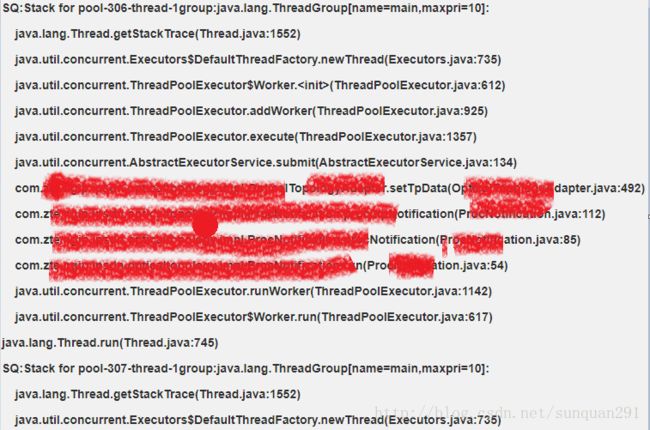几种OOM异常分析
OOM为out of memory的简称,称之为内存溢出。
程序中常见的打印有如下几类:
一:
如图:

Java应用程序在启动时会指定所需要的内存大小,其主要被分割成两个不同的部分,分别为Head space(堆空间-Xmx指定)和Permegen(永久代-XX:MaxPermSize指定),
通常来说,造成如上图异常的基本上程序代码问题而造成的内存泄露。这种异常,通过dump+EMA可以轻松定位。(EMA虽功能强大,但对机器性能内存要求极高)
二:
Java.lang.OutOfMemeoryError:GC overhead limit exceeded
如上异常,即程序在垃圾回收上花费了98%的时间,却收集不回2%的空间,通常这样的异常伴随着CPU的冲高。定位方法同上。
三:
Java.lang.OutOfMemoryError: PermGen space(JAVA8引入了Metaspace区域)
永久代内存被耗尽,永久代的作用是存储每个类的信息,如类加载器引用、运行池常量池、字段数据、方法数据、方法代码、方法字节码等。基本可以推断PermGen占用大小取决于被加载的数量以及类的大小。定位方法同上。
还有很多OOM异常,甚至会触发操作系统的OOM killer去杀掉其它进程。
四:
本节主要讨论下面一种OOM,如图

产生这种异常的原因是由于系统在不停地创建大量的线程,且不进行释放。系统的内存是有限的,分配给JAVA应用的程序也是有限的,系统自身能允许创建的最大线程数计算规则:
(MaxProcessMemory-JVMMemory-ReservedOsMemory)/ThreadStackSize
其中
MaxProcessMemory:指的是一个进程的最大内存
JVMMemory :JVM内存
ReservedOsMemory:保留的操作系统内存
ThreadStackSize:线程栈的大小
从公式中可以得出结论,系统可创建线程数量与分配给JVM内存大小成反比。
在java程序中,创建一个线程,虚拟机会在JVM内存创建一个Thread对象同时创建一个操作系统线程,且系统线程的内存不占用JVMMemory,而占用系统中剩下的内存,即(MaxProcessMemory - JVMMemory - ReservedOsMemory)。
结论很明显:程序创建的线程不可能无限大。
先讨论第一种情况,即经jstack或dump后,线程的数量确在系统要求的阀值内,报上面异常,该如何?
1.参考之前的参数,可以修改两个变量JVMMemory和ThreadStackSize来满足更多线程创建的要求。
-Xss1024k -Xms4096m -Xmx4096m
2.查看是否操作系统限制了可创建线程数量
执行ulimit -u 可以查看当前用户可创建线程量,如果不满足要求,可以通过修改配置文件调整其大小:
相关配置文件在etc/security/limit.d/XX-nproc.conf中
由于上面配置不合理造成而产生异常,个人认为应属小概率事件。
第二种情况,是程序中存在线程泄露,代码本身有问题,在某些场景,条件下存在线程不断创建而不销毁的BUG。
先看一段代码(取自业务真实代码稍加改写):
package com.zte.sunquan.demo.netty.server;
import com.google.common.collect.Maps;
import java.util.Map;
import java.util.concurrent.ExecutorService;
import java.util.concurrent.Executors;
public class MainController {
private ExecutorService executor = Executors.newSingleThreadExecutor();
private static Map map = Maps.newConcurrentMap();
public void submitTask() {
for (int i = 0; i < 10; i++) {
executor.submit(new Runnable() {
@Override
public void run() {
System.out.println(Thread.currentThread().getName() + "正处理");
}
});
}
}
public static void main(String[] args) throws InterruptedException {
while (true) {
MainController ct1 = new MainController();
map.put("1", ct1);
ct1.submitTask();
map.remove("1");
}
}
} 如上表的程序就存在线程泄露,开发人员误以为从map中移除,对象就可以释放,最终交由GC回收,但其实在创建的对象中创建的线程池,由于未关闭,执行完任务后,进入waiting状态,是不会释放的,随着程序运行,线程会越积越多,最终导致OOM的异常。
又或者将main函数,改为一个监听入口,在一般甚至短暂的压力测试中,虽然线程较多,但系统仍可以正常进行,误以为系统运行正常,但大业务、多节点、网络震荡、长时间,商用等能够大量触发该监听的场景中,这类问题才以最终kill系统进程暴露出来。
此外,如上表中的代码,线程池创建的进程,采用Executors中DefaultThreadFactory提供的pool-XXX-thread-XXX命名规则,诚然可以通过jstack打印线程调用栈,但如下面的打印:
.....
"pool-2577-thread-1" #8681 prio=5 os_prio=0 tid=0x00007f8ea4de7800 nid=0x6a0b waiting on condition [0x00007f8cae227000]
java.lang.Thread.State: WAITING (parking)
at sun.misc.Unsafe.park(Native Method)
- parking to wait for <0x000000057136f4b8> (a java.util.concurrent.locks.AbstractQueuedSynchronizer$ConditionObject)
at java.util.concurrent.locks.LockSupport.park(LockSupport.java:175)
at java.util.concurrent.locks.AbstractQueuedSynchronizer$ConditionObject.await(AbstractQueuedSynchronizer.java:2039)
at java.util.concurrent.LinkedBlockingQueue.take(LinkedBlockingQueue.java:442)
at java.util.concurrent.ThreadPoolExecutor.getTask(ThreadPoolExecutor.java:1067)
at java.util.concurrent.ThreadPoolExecutor.runWorker(ThreadPoolExecutor.java:1127)
at java.util.concurrent.ThreadPoolExecutor$Worker.run(ThreadPoolExecutor.java:617)
at java.lang.Thread.run(Thread.java:745)
"pool-2576-thread-1" #8680 prio=5 os_prio=0 tid=0x00007f8ea4de6000 nid=0x6a0a waiting on condition [0x00007f8cae72c000]
java.lang.Thread.State: WAITING (parking)
at sun.misc.Unsafe.park(Native Method)
- parking to wait for <0x000000057136fa20> (a java.util.concurrent.locks.AbstractQueuedSynchronizer$ConditionObject)
......完整打印一直是从pool-1-thread-1到pool-5406-thread-1,很明显代码一直在创建线程池,但从打印输出,却无法分析出罪魁祸首是谁?接下来自然,会去系统日志中搜索pool-开头的线程打印,期望能找到线索,遗憾的是,什么信息也没有。此时问题定位,卡壳了。但可以肯定,代码肯定有前面例子中类似的写法。此时,走查代码,不失为一个好办法。
线索就此断掉了。。。。。
但考虑到是使用JDK并发包提供的功能,那在JDK中Executors类中,创建线程时,增加打印,强制将调用栈的信息打印出来,是否可以找到蛛丝马迹?
确定JDK版本--->获取源码---->修改代码--->编译-------->合入rt.jar ------->复现
我们将最终信息输入到了var/log目录下,需要提前将该目录的权限开放chmod 777 -R
输出日志中,对一些连续创建的线程,观察打印信息,幸运女神出现了,OpticalTopologyAdapter,抓到你了。问题解决!
这种问题的出现,归根到底,是没有对线程池进行管理,开发人员对于线程池的滥用,影响了程序稳定性。
修改的源文件如下:
package java.util.concurrent;
import sun.security.util.SecurityConstants;
import java.io.File;
import java.io.FileWriter;
import java.io.IOException;
import java.security.AccessControlContext;
import java.security.AccessControlException;
import java.security.AccessController;
import java.security.PrivilegedAction;
import java.security.PrivilegedActionException;
import java.security.PrivilegedExceptionAction;
import java.util.Collection;
import java.util.List;
import java.util.concurrent.atomic.AtomicInteger;
public class Executors {
public static ExecutorService newFixedThreadPool(int nThreads) {
StackTraceElement[] elements = Thread.currentThread().getStackTrace();
recordThreadStackInfo("SQ:FixThreadPool: " + Thread.currentThread().getName() + nThreads, elements);
return new ThreadPoolExecutor(nThreads, nThreads,
0L, TimeUnit.MILLISECONDS,
new LinkedBlockingQueue());
}
public static ExecutorService newWorkStealingPool(int parallelism) {
return new ForkJoinPool
(parallelism,
ForkJoinPool.defaultForkJoinWorkerThreadFactory,
null, true);
}
public static ExecutorService newWorkStealingPool() {
return new ForkJoinPool
(Runtime.getRuntime().availableProcessors(),
ForkJoinPool.defaultForkJoinWorkerThreadFactory,
null, true);
}
public static ExecutorService newFixedThreadPool(int nThreads, ThreadFactory threadFactory) {
StackTraceElement[] elements = Thread.currentThread().getStackTrace();
recordThreadStackInfo("SQ2:FixThreadPool: " + Thread.currentThread().getName() + nThreads, elements);
return new ThreadPoolExecutor(nThreads, nThreads,
0L, TimeUnit.MILLISECONDS,
new LinkedBlockingQueue(),
threadFactory);
}
public static ExecutorService newSingleThreadExecutor() {
StackTraceElement[] elements = Thread.currentThread().getStackTrace();
recordThreadStackInfo("SQ1:SingleThread: " + Thread.currentThread().getName(), elements);
return new FinalizableDelegatedExecutorService
(new ThreadPoolExecutor(1, 1,
0L, TimeUnit.MILLISECONDS,
new LinkedBlockingQueue()));
}
public static ExecutorService newSingleThreadExecutor(ThreadFactory threadFactory) {
StackTraceElement[] elements = Thread.currentThread().getStackTrace();
recordThreadStackInfo("SQ2:SingleThread: " + Thread.currentThread().getName(), elements);
return new FinalizableDelegatedExecutorService
(new ThreadPoolExecutor(1, 1,
0L, TimeUnit.MILLISECONDS,
new LinkedBlockingQueue(),
threadFactory));
}
public static ExecutorService newCachedThreadPool() {
return new ThreadPoolExecutor(0, Integer.MAX_VALUE,
60L, TimeUnit.SECONDS,
new SynchronousQueue());
}
public static ExecutorService newCachedThreadPool(ThreadFactory threadFactory) {
return new ThreadPoolExecutor(0, Integer.MAX_VALUE,
60L, TimeUnit.SECONDS,
new SynchronousQueue(),
threadFactory);
}
public static ScheduledExecutorService newSingleThreadScheduledExecutor() {
return new DelegatedScheduledExecutorService
(new ScheduledThreadPoolExecutor(1));
}
public static ScheduledExecutorService newSingleThreadScheduledExecutor(ThreadFactory threadFactory) {
return new DelegatedScheduledExecutorService
(new ScheduledThreadPoolExecutor(1, threadFactory));
}
public static ScheduledExecutorService newScheduledThreadPool(int corePoolSize) {
return new ScheduledThreadPoolExecutor(corePoolSize);
}
public static ScheduledExecutorService newScheduledThreadPool(
int corePoolSize, ThreadFactory threadFactory) {
return new ScheduledThreadPoolExecutor(corePoolSize, threadFactory);
}
public static ExecutorService unconfigurableExecutorService(ExecutorService executor) {
if (executor == null)
throw new NullPointerException();
return new DelegatedExecutorService(executor);
}
public static ScheduledExecutorService unconfigurableScheduledExecutorService(ScheduledExecutorService executor) {
if (executor == null)
throw new NullPointerException();
return new DelegatedScheduledExecutorService(executor);
}
public static ThreadFactory defaultThreadFactory() {
return new DefaultThreadFactory();
}
public static ThreadFactory privilegedThreadFactory() {
return new PrivilegedThreadFactory();
}
public static Callable callable(Runnable task, T result) {
if (task == null)
throw new NullPointerException();
return new RunnableAdapter(task, result);
}
public static Callable 因此有了下面的几点建议:
1.如果使用JDK创建线程池,必须指定命名规则,参考
ThreadFactory build=new ThreadFactoryBuilder().setPriority(Thread.NORM_PRIORITY)
.setDaemon(false)
.setNameFormat("SQ-Creat-%d")
.build();
Executors.newSingleThreadScheduledExecutor(build);但使用上面的方式只能设置线程名,而线程池的数目,是无法判断的。简而言之,即有SQ-Create-1,SQ-Create-2.SQ-Create-3,无法判断出这是一个线程池中三个线程,还是存在于两个线程池中。
其实,更简单的方法,只要实现ThreadFactory,稍等改动,则可以实现。(使用UserThreadFactory强制使用必须传入线程池名)
package com.zte.sunquan.demo.executor;
import java.util.concurrent.ThreadFactory;
import java.util.concurrent.atomic.AtomicInteger;
/**
* Created by 10184538 on 2018/1/4.
*/
public class UserThreadFactory implements ThreadFactory {
private static final AtomicInteger poolNumber = new AtomicInteger(1);
private final ThreadGroup group;
private final AtomicInteger threadNumber = new AtomicInteger(1);
private final String namePrefix;
private UserThreadFactory(String threadPoolName) {
SecurityManager s = System.getSecurityManager();
group = (s != null) ? s.getThreadGroup() :
Thread.currentThread().getThreadGroup();
namePrefix = threadPoolName + "-" +
poolNumber.getAndIncrement() +
"-thread-";
}
public Thread newThread(Runnable r) {
Thread t = new Thread(group, r,
namePrefix + threadNumber.getAndIncrement(),
0);
if (t.isDaemon())
t.setDaemon(false);
if (t.getPriority() != Thread.NORM_PRIORITY)
t.setPriority(Thread.NORM_PRIORITY);
return t;
}
public static UserThreadFactory build(String poolThreadName) {
return new UserThreadFactory(poolThreadName);
}
}3.最后简单介绍下ONOS线程池的封装使用(以下参考ONOS1.5.2版本)
Onos中考虑到线程的管理,使用了:
SharedExecutors
SharedExecutorService
SharedScheduledExecutors
ShardScheduleExecutorServce
对JDK的Executors进行了封装,增加了部分管理。同时其特点提供的GroupedThreadFactory支持线程的子父节关系定义管理。如:
@Test
public void test() throws InterruptedException {
//对每一个事件都要定义其所在的事件组,事件名,并保持相关继承关系
CountDownLatch countDownLatch = new CountDownLatch(1);
ExecutorService executorService =
Executors.newFixedThreadPool(2, getFactory("sqGroup/a/b", "sqThread%d"));
executorService.execute(() -> {
System.out.println("parent thread group name: " + Thread.currentThread().getThreadGroup().getParent().getName());
System.out.println("current thread group name: " + Thread.currentThread().getThreadGroup().getName());
System.out.println("current thread name: " + Thread.currentThread().getName());
countDownLatch.countDown();
});
countDownLatch.await();
System.out.println(Thread.currentThread().getThreadGroup().getName());
}打印:
| parent thread group name: sqGroup/a current thread group name: sqGroup/a/b current thread name: sqThread0 main |
|---|
总结:本人故障定位中查到的N多OOM问题,原因不外乎以下3类
1、线程池不管理式滥用
2、本地缓存滥用(如只需要使用Node的id,但将整个Node所有信息都缓存)
3、特殊场景考虑不足(如采用单线程处理复杂业务,环境震荡+多设备下积压任务暴增)
==============利用gc.log进行OOM监控=======================
针对JVM的监听,JDK默认提供了如jconsole、jvisualVM工具都非常好用,本节介绍利用打开gc的日志功能,进行OOM的监控。
首先需要对JAVA程序添加执行参数:
-XX:+PrintGC 输出GC日志
-XX:+PrintGCDetails 输出GC的详细日志
-XX:+PrintGCTimeStamps 输出GC的时间戳(以基准时间的形式)
-XX:+PrintGCDateStamps 输出GC的时间戳(以日期的形式,如 2013-05-04T21:53:59.234+0800)
-XX:+PrintHeapAtGC 在进行GC的前后打印出堆的信息
-Xloggc:../logs/gc.log 日志文件的输出路径
示例参数配置:
-xmx100M -XX:+PrintGCDetails -Xloggc:../logs/gc.log -XX:+PrintGCDetails -Xmx设置堆内存
输出日志的详细介绍:

总共分配了100M堆内存空间,老年代+年轻代=堆
就堆内存,此次GC共回收了79186-75828=3356=3.279M内存,能回收空间已经非常少了。
同时从PSYoungGen回收10612-7254=3558=3.474M内存
3558-3356=202K,说明有202K的空间在年轻代释放,却传入年老代继续占用
下一条日志输出:
2018-01-03T10:53:52.281+0800: 11.052: [Full GC (Allocation Failure) [PSYoungGen: 7254K->7254K(24064K)] [ParOldGen: 68574K->68486K(68608K)] 75828K->75740K(92672K), [Metaspace: 3357K->3357K(1056768K)], 0.6010057 secs] [Times: user=2.08 sys=0.00, real=0.60 secs]
68574-68486=88K
75828-75740=88K
此次FullGC 只能释放老年代的88K空间
ps.对于分析gc.log,提供一种图形化工具辅助分析
gcviewer-1.3.6